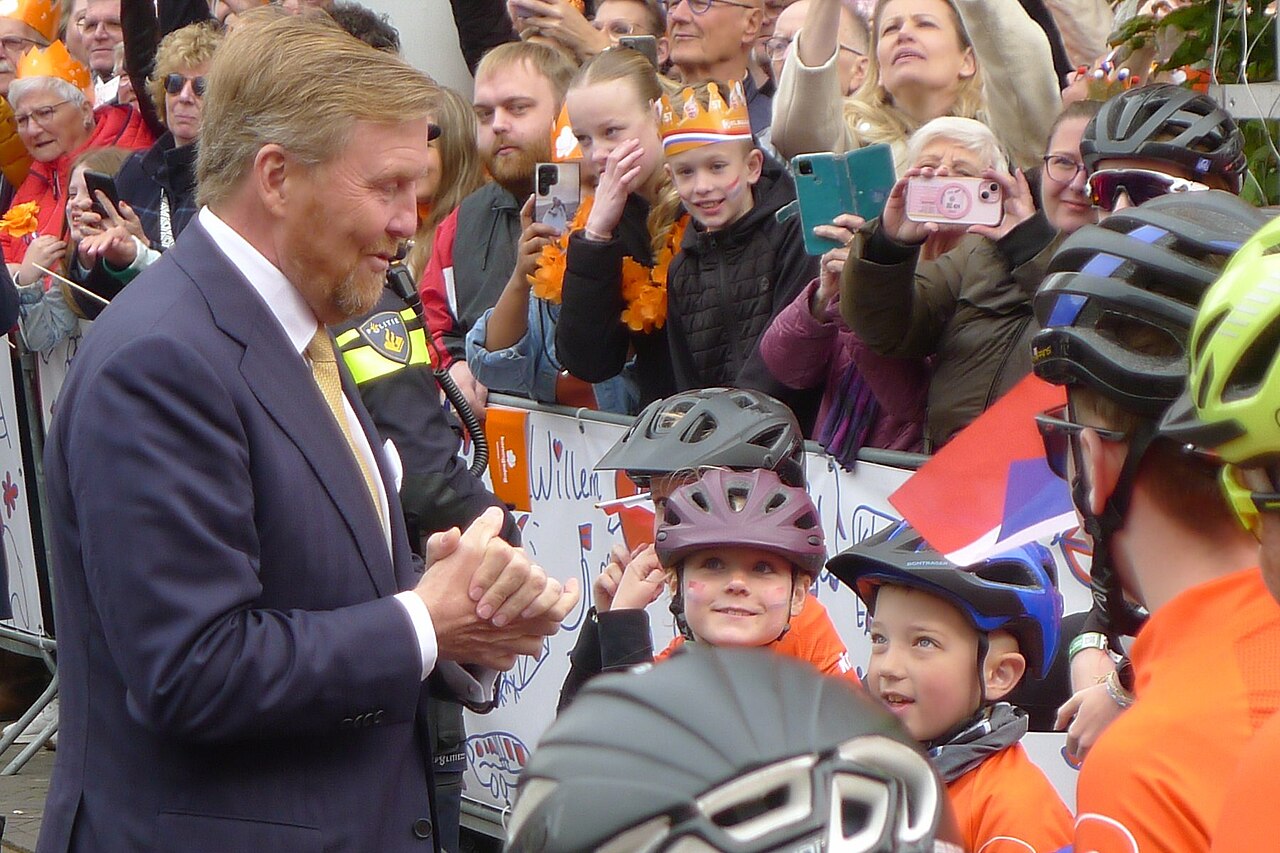by Susan Flantzer
© Unofficial Royalty 2024

King Willem-Alexander visiting Emmen, the Netherlands on King’s Day in 2024; Credit – Door Erikt – Eigen werk https://commons.wikimedia.org/w/index.php?curid=147787647
King’s Day (Koningsdag in Dutch) is a national holiday, marking the birth of King Willem-Alexander on April 27, 1967. It is celebrated on April 27 or April 26 if April 27 is a Sunday. When the Dutch monarch is female, the holiday is known as Queen’s Day (Koninginnedag in Dutch).
History

Queen Wilhelmina on Queen’s Day, August 31, 1946, two years before her death. Left to Right: Princess Juliana (later Queen), Prince Bernhard (Juliana’s husband), Queen Wilhelmina, unidentified man, Princess Beatrix (later Queen), Princess Margriet (sitting on step), and Princess Irene; Credit – Wikipedia
King Willem III, who reigned from 1849 to 1890, was an unpopular ruler. Faced with an unpopular monarchy, the States-General, the Dutch legislature, considered ways to promote national unity. Although King Willem III was disliked, his young daughter, only surviving child, and successor, Princess Wilhelmina (born 1880, later Queen Wilhelmina) was not. Intermittently, a holiday had been held on King Willem III’s birthday. J. W. R. Gerlach, editor of the newspaper Utrechts Provinciaal en Stedelijk Dagblad, proposed that Princess Wilhelmina’s birthday be observed for patriotic celebration and national reconciliation.
On the first Princess’ Day in 1885, celebrations occurred only in Utrecht where the five-year-old Princess Wilhelmina was paraded through the streets, waving to the crowds. Eventually, other towns and cities held celebrations, many organizing activities for children. Queen Wilhelmina (reigned 1890 – 1948, abdicated in favor of her daughter Juliana) rarely attended Queen’s Day celebrations after reaching adulthood.

Queen Juliana (second from the left) and the Dutch royal family standing on the steps of Soestdijk Palace on Queen’s Day in 1960; Credit – Wikipedia
Queen Juliana (reigned 1948 – 1980, abdicated in favor of her daughter Beatrix) spent each Queen’s Day at Soestdijk Palace in Baarn. The Dutch royal family stood on the palace steps watching a procession of Dutch people in a flower parade. Many Dutch people left flowers and gifts for the royal family on the palace steps. The flower parade was broadcast on television from the mid-1950s.
Queen Beatrix on Queen’s Day in 2010
Queen Beatrix (reigned 1980 – 2013, abdicated in favor of her son Willem-Alexander) decided that rather than remaining at a palace and letting the Dutch people come to her, she would instead visit two towns or cities each year for Queen’s Day celebrations, accompanied by members of the Dutch royal family.
Date Changes
The holiday was originally held as Princess’ Day (Prinsessedag in Dutch) on August 31, 1885, the fifth birthday of Princess Wilhelmina, the only surviving child of King Willem III of the Netherlands and the heir presumptive to the Dutch throne. When ten-year-old Wilhelmina ascended the Dutch throne after her father died in 1890, the holiday became known as Queen’s Day (Koninginnedag) and was first celebrated on August 31, 1891.
In September 1948, when Queen Wilhelmina died, her daughter Juliana became Queen of the Netherlands and Queen’s Day was moved to April 30, Queen Juliana’s birthday. Queen Beatrix, Queen Juliana’s daughter and successor, opted to keep Queen’s Day on April 30 as a tribute to her mother. Queen Beatrix’s birthday was January 31, in the middle of winter, not a time conducive to outdoor activities.
Queen Beatrix abdicated on Queen’s Day in 2013, in favor of her son Willem-Alexander, the first King of the Netherlands in 123 years. The holiday became known as King’s Day (Koningsdag) and was moved to April 27, King Willem-Alexander’s birthday.
What Happens?
Princess Caterina Amalia, Queen Máxima, King Willem-Alexander, Princess Alexia, and Princess Ariane on King’s Day on April 27, 2024, in Emmen, Netherlands
The older generation of the Dutch royal family usually no longer attends events on King’s Day. Instead, King Willem-Alexander, Queen Máxima, and their three daughters Princess Catharina-Amalia (The Princess of Orange), Princess Alexia, and Princess Ariane make appearances. The King’s brother Prince Constantijn and his wife Princess Laurentien, the four sons of Princess Margriet, first cousins of King Willem-Alexander, and their spouses also make appearances.
King Willem-Alexander visits only one city or town on King’s Day. That city or town is given the opportunity to present itself to the rest of the Netherlands, focusing on music, sports, visual arts, design, technology, business, historical heritage, social initiatives, or dreams for the future.

People dressed in orange on Amsterdam’s canals on Queen’s Day in 2010; By Carmelrmd – Own work, CC BY-SA 3.0, https://commons.wikimedia.org/w/index.php?curid=21023947
There are many celebrations throughout the Netherlands. Participants in King’s Day often dress in orange and dye their hair orange in honor of the House of Orange-Nassau. The vrijmarkt (free market) is a nationwide flea market. King’s Day is the only day of the year that the Dutch government permits sales on the street without a permit or the payment of value-added tax. Many large-scale celebrations are held on King’s Day with many concerts and special events in public spaces, particularly in Amsterdam. An outdoor concert is held on Amsterdam’s Museumplein, where as many as 800,000 people attend.
This article is the intellectual property of Unofficial Royalty and is NOT TO BE COPIED, EDITED, OR POSTED IN ANY FORM ON ANOTHER WEBSITE under any circumstances. It is permissible to use a link that directs to Unofficial Royalty.
Works Cited
- Koningsdag (Nederland). (2024). Wikipedia. https://nl.wikipedia.org/wiki/Koningsdag_(Nederland)
- Wikipedia Contributors. (2019). Koningsdag. Wikipedia; Wikimedia Foundation. https://en.wikipedia.org/wiki/Koningsdag
- Zaken, M. van A. (2014). Geschiedenis Koningsdag – Koningsdag – Het Koninklijk Huis. Www.koninklijkhuis.nl. https://www.koninklijkhuis.nl/onderwerpen/koningsdag/geschiedenis-koningsdag
